Climbing in the 2025 Giro d'Italia
By Mikkel-T ([email protected])
Posted on May 6, 2025
Contents
Intro
The 2025 Giro d'Italia is just around the corner, at sanluca.cc, we can't wait. In the past week, we have been hard at work uploading routes and creating fun and interesting graphics about Il Giro. You can find all info about the race right here.
This year, the Giro d'Italia starts in Albania with a punchy stage, followed by an ITT and another difficult stage, after which they will have a rest day and go to Italy. We have decided to make an overview of all the climbing in this year's Giro that we hope you will find helpful.
Please note that this blog post only focuses on the climbing difficulty of the stages, and doesn't take the ITT's and gravel stage into account when discussing the route and how hard it is.
When this post refers to the three weeks of the Giro, the first week is stages 1-9, the second week is stages 10-15 and the third week is stages 16-21.
The stages and their categories
21 stages, 3441 km and a total vertical gain of just over 47,000 meters are just some of the numbers that the riders of the 2025 Giro d'Italia can look forward to, including 2 ITT's and a stage on the Strade Bianche of Siena.
As with any grand tour, there has got to be some variation so not all stages are the same. At sanluca.cc, we have our own tool for categorizing routes we add to our website. This tool categorizes all routes in one of the following categories:
- Flat
- Lumpy
- Hilly
- Medium Mountain
- Mountain
For this Giro, we have 9 mountain stages and no flat stages. Of course, this doesn't mean that there will be no sprint stages, just that there will be no stages where the only elevation will be a highway bridge. Even the ITT on stage 10 is considered lumpy by our tool, due to the small hill in the middle. It is also important to note that the tool doesn't consider where on the route the elevation is. For example, stage 6 has a lot of elevation in the first part, and long climbs, which is why it is categorized as "Medium Mountain", even though it is mostly in the last part. Stage 9 has more or less the same elevation as stage 6, but is only categorized as "Hilly", due to the elevation being spread out more. An overview of the number of stages in different categories can be seen here:
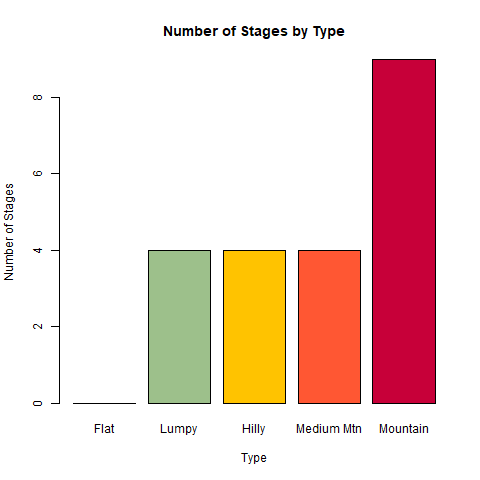
This doesn't give you the full picture of course. It also depends on when in the race the different stages come. The graph below shows the number of stages in each category for each of the weeks (as defined above):
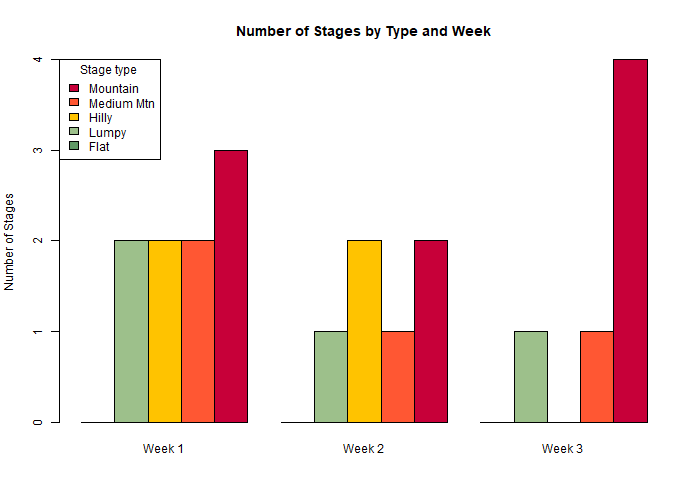
First of all, this tells us that the last week is going to be very demanding, with all but two stages being mountain stages. One of the stages is of course the final sprint stage, while the other one is stage 18, which will most likely also be a sprint.
It also tells us that week 2 has the potential to be kind of dull, with only two mountain stages that both have the potential to be for the breakaway and without any major GC fights other than the ITT on stage 10. We might see some fights for seconds on the final climb of stage 13 (the medium mountain stage), but other than that, the Red Bull Km and final sprints are going to be the most exciting for week 2.
While the categorizations can say a lot, the vertical gain per stage is also an important indicator. The below graphic shows the vertical gain per stage, with the color being the stage category:
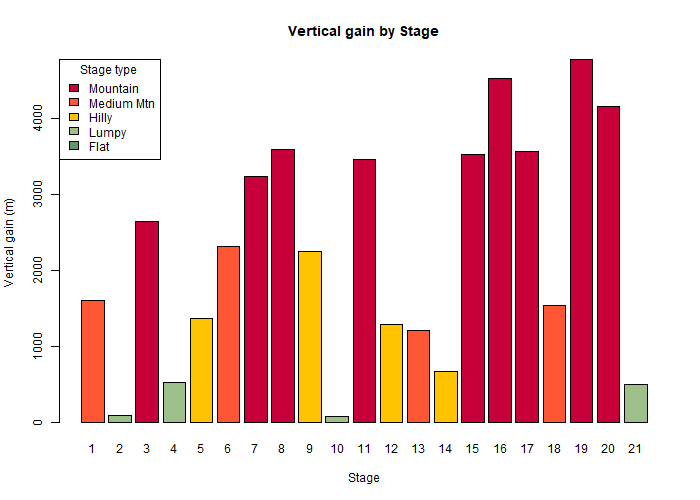
Again, the last week is the highlight, with only the two stages mentioned before not being mountain stages with a potential for GC fights. To put it into perspective, week 3 will almost have twice the vertical gain as week 2, and also more than week 1 even though that has two more stages than the other weeks. More info in the table below:
| Week | Distance (km) | Vertical gain (m) | Vertical gain/km |
|---|---|---|---|
| 1 | 1444.5 | 17660 | 12.2 m/km |
| 2 | 980.7 | 10270 | 10.5 m/km |
| 3 | 1016.4 | 19100 | 18.8 m/km |
So almost the double vertical gain/km in week 3 compared to week 2, and almost also compared to week 1. What is worth noting though, is that only stage 16 and stage 20 finish uphill. The two other mountain stages finish after a downhill section and about 1 km of flat road. For stage 17, the riders will have 9 km from the top of Le Motte to get to the finish line 220 meters below the top, on stage 19 it is only 5 km, and the finish line is just 150 meters below the top of Antagnod.
The categorized climbs
As always, RCS has categorized climbs along the route for the KOM competition (the Maglia Azzura). There are the usual categories 1-4 where 1 is the hardest, and the Cima Coppi for the highest point on the route (which we show as a HC climb). This year's Cima Coppi is the Colle delle Finestre on stage 20. In total, there are 54 categorized climbs with a total length of 479 km and a vertical gain of almost 29,000 m. A list of all the categorized climbs (and other segments) can be found here.
The longest climb will be Monte Grappa on stage 15 with a length of 25 km while the shortest climb will be Cagliole on stage 8 with a length of just 743 meters (just 3 meters shorter than Saver, which is the final climb on the circuit of stage 14).
The steepest climb will be the Muro di Ca' del Poggio, also on stage 15 with an average gradient of 12.3% (131 meters of ascent on 1.06 km), on the other hand, the least steep climb will be San Martino in Grania on stage 9 with an average gradient of just 2.9%. An important note on that climb is where we have decided to measure it from: in our profiles, the climb is 5.7 km long, starting from an altitude of 170 meters and going both up and down. If we measure only the final kilometer, it will have a gradient of 7.3%, and don't forget that it's on gravel. The next in line of the least steep climbs is Monteforte Irpino on stage 6 with an average gradient of 3.1%.
Meanwhile, the climb with the most vertical gain is (as you might have guessed) the Cima Coppi: Colle delle Finestre, with a whopping 1678 meters of vertical gain (also with some of it being on gravel). The climb with the least vertical gain Saver, the final climb on the circuit of stage 14 with just 60 meters of vertical gain, though they will be doing it twice.
The number of climbs per category can be seen in the graph below:
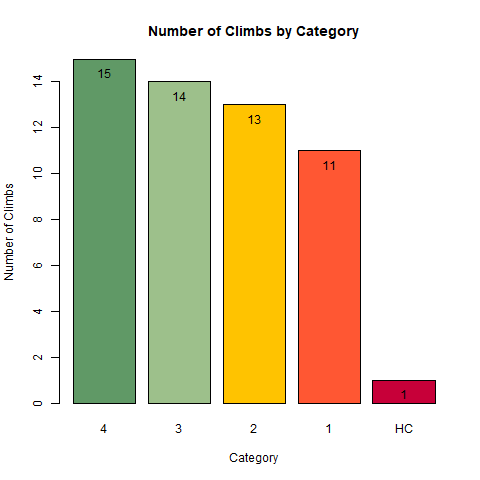
As you could have probably guessed, there are more climbs in the easier categories than in the harder ones, but not by as big of a margin as in other races (example: Tour de France 2024). There is also only one HC climb, the Cima Coppi.
Although this is the case, most of the climbing is still done on the harder categories. The category 1 climbs account for around 35% of the total categorized climbing (165 km) while the category 4 climbs account for under 10% (41 km).
| Cat | Length (km) | Vertical gain (m) |
|---|---|---|
| HC (Cima Coppi) | 18.3 | 1678 |
| 1 | 165 | 11700 |
| 2 | 141.7 | 7540 |
| 3 | 113 | 5550 |
| 4 | 41.4 | 2400 |
Yet again, it is interesting to look at the numbers spread out over each week, just as much for the GC as for the KOM competition. The following graph shows the number of climbs by category and week:
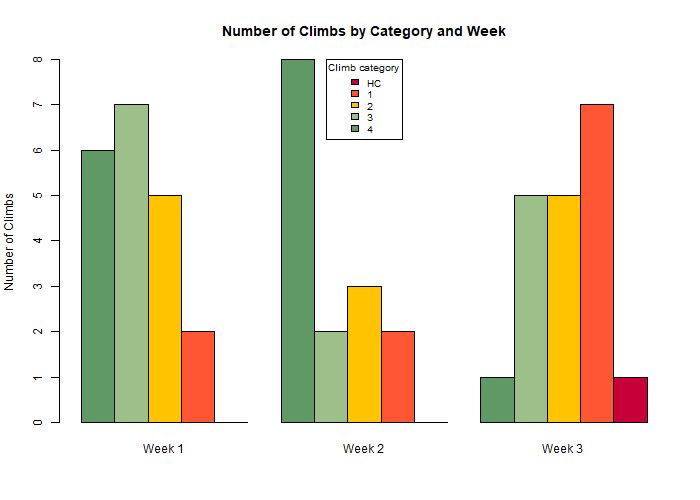
This shows the same as I have pointed out a couple times in this post, that week 3 is harder than the two other weeks. Weeks 1 and 2 combined have 4 cat 1 climbs and 8 cat 2 climbs, while week 3 alone has 7 cat 1 climbs and 5 cat 2 climbs (both stage 16 and 19 have 3 cat 1 climbs).
In general, climbs with higher categories are often longer and has more vertical gain than climbs with lower categories. This can also be seen on week 3, with no less than 20% of the total distance in week 3 being done on categorized climbs (227.6 km), for both week 1 and 2, that number is about 10%.
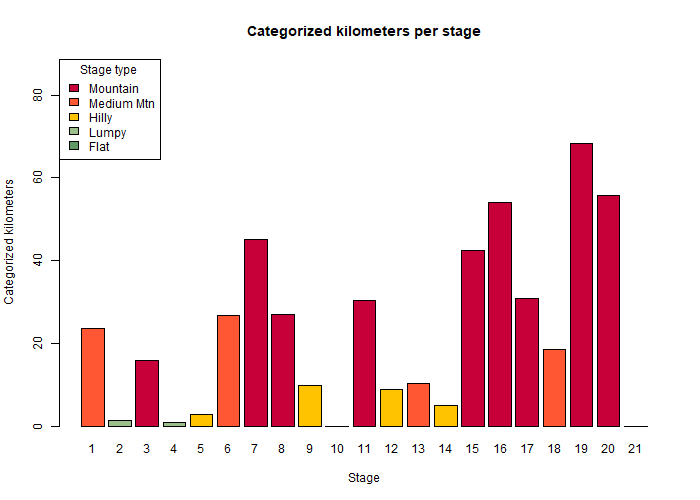
In the same way, about 75% of the total vertical gain in week 3 is done on categorized climbs (14370 m), while that number is about 50% for both week 1 and 2.
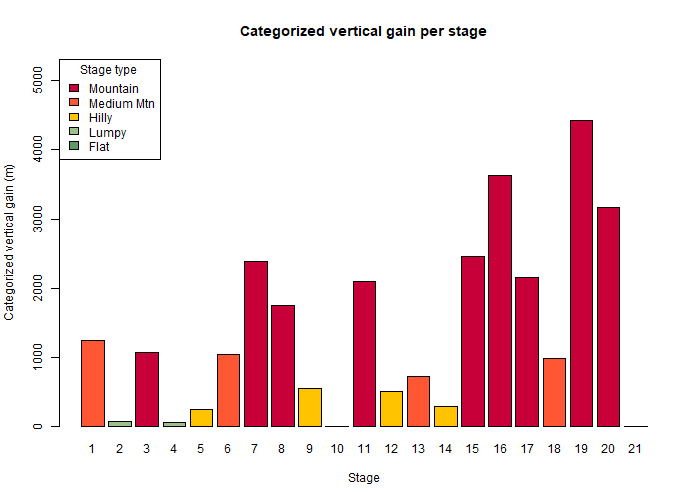
Conclusion
In conclusion, it looks like a Giro that is split between being hard and dull, with week 2 looking like a week where you are probably fine if you turn on the tv 10-20 km before the finish, while week 3 has the ability to deliver a show. With the way week 3 is made, the winner of the KOM competition and the Maglia Azzura might first be known very late in the race, and hopefully there will be some riders targeting it. Stage 1 seems like it should be able to deliver an exciting final and race for the first Maglia Rosa, but should also be able to give us some pointers as to who can win the Maglia Ciclamino, which there will hopefully be some tension about in week 2.
Let's also hope that week 3 isn't too "scary" for the GC competitors, so they will ride like in 2023 when they were basically all waiting for the ITT to Monte Lussari on stage 20. Finestre is definitely not an easy climb, with a length of 18.3 km and an average gradient of 9.2% (plus 8 km of gravel and a Red Bull Km sprint), something is bound to happen here, but hopefully it will not be the only climb in week 3 with some excitement.